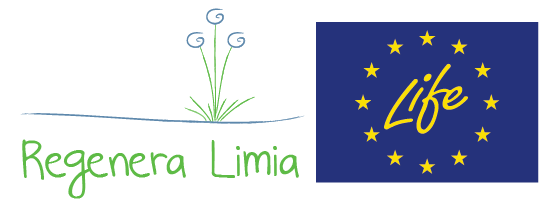Sand Ponds
[cmsms_row data_width=”boxed” data_padding_left=”3″ data_padding_right=”3″ data_color=”default” data_bg_color=”#ffffff” data_bg_position=”top center” data_bg_repeat=”no-repeat” data_bg_attachment=”scroll” data_bg_size=”cover” data_bg_parallax_ratio=”0.5″ data_color_overlay=”#000000″ data_overlay_opacity=”50″ data_padding_top=”0″ data_padding_bottom=”50″][cmsms_column data_width=”1/1″]
[cmsms_divider type=”transparent” margin_top=”10″ margin_bottom=”10″ animation_delay=”0″]
[cmsms_text animation_delay=”0″]
The mining activity of sand extraction in the Region of the Limia in the last 15 years is one of the main industries of the primary sector. This sector is developed thanks to the sedimentary inputs that the Limia River and its tributaries have been depositing in their alluvial plains during their hydromorphological history, the result of this activity in the region is the creation of innumerable lagoons of artificial origin in the vicinity of the river channels of the Comarca of A Limia.
[/cmsms_text]
[cmsms_divider type=”transparent” margin_top=”10″ margin_bottom=”10″ animation_delay=”0″]
[cmsms_image align=”center” link=”http://regeneralimia.org/wp-content/uploads/2017/05/Captura.png” animation_delay=”0″]4840|http://regeneralimia.org/wp-content/uploads/2017/05/Captura.png|full[/cmsms_image]
[cmsms_divider type=”transparent” margin_top=”10″ margin_bottom=”10″ animation_delay=”0″]
[cmsms_text animation_delay=”0″]
The Life Regenera Limia project, in its desire to improve aquatic ecosystems by taking advantage of its nutrient absorption capacity, has selected two sand pools near the Antela Channel but disconnected from it, to hydraulically connect them to the channel, causing part of the year circulate water of the canal by said ponds, with the aim of integrating them in the hydrological cycle and allow the development of biological processes that favor the reduction of nutrients present in the waters.
[/cmsms_text]
[cmsms_divider type=”transparent” margin_top=”10″ margin_bottom=”10″ animation_delay=”0″]
[cmsms_image align=”center” link=”http://regeneralimia.org/wp-content/uploads/2017/05/Capturaº1.png” animation_delay=”0″]4841|http://regeneralimia.org/wp-content/uploads/2017/05/Capturaº1.png|full[/cmsms_image]
[cmsms_divider type=”transparent” margin_top=”10″ margin_bottom=”10″ animation_delay=”0″]
[cmsms_text animation_delay=”0″]
What have the jobs consisted of?
Two gaps located on the right bank of the Laguna de Antela canal were selected, but disconnected from the same by the service road that mainly used trucks of great tonnage of sand transport.
At the beginning of October work began on the connection between the two ponds and the canal, constructing a total of three steps in the road on the right bank of the canal with prefabricated frames: one gives passage to the water from the canal to the ponds, another of connection between both ponds and a third to give out the circulating water. The three steps have been integrated environmentally with stone bed in its interior, using irregular stone breakwater for the creation of breakwaters, and with final planting of willow cuttings in the nearby slopes to cause that the own vegetation who colonizes the modified slopes by the works.
[/cmsms_text]
[cmsms_text]
[/cmsms_text][cmsms_gallery layout=”gallery” image_size_gallery=”medium” gallery_columns=”4″ gallery_links=”lightbox” animation_delay=”0″]4853|http://regeneralimia.org/wp-content/uploads/2017/05/ejecucion1-200×200.jpg,4854|http://regeneralimia.org/wp-content/uploads/2017/05/ejecucion2-200×200.jpg,4855|http://regeneralimia.org/wp-content/uploads/2017/05/ejecucion3-200×200.png,4856|http://regeneralimia.org/wp-content/uploads/2017/05/ejecucion4-200×200.jpg[/cmsms_gallery][cmsms_text animation_delay=”0″]
On the other hand, existing ecosystems have been improved by creating two progressive floodplain platforms (slopes less than 10º and depths not higher than 10 cm during the vegetative period) to promote colonization by hygrophilous plant communities adapted to flood periods and specialists in the retention of nutrients from the water.
[/cmsms_text]
[cmsms_divider type=”transparent” margin_top=”10″ margin_bottom=”10″ animation_delay=”0″]
[cmsms_gallery layout=”gallery” image_size_gallery=”medium” gallery_columns=”4″ gallery_links=”lightbox” animation_delay=”0″]4857|http://regeneralimia.org/wp-content/uploads/2017/05/recuperacion1.emf_-200×200.jpg,4858|http://regeneralimia.org/wp-content/uploads/2017/05/recuperacion2.emf_-200×200.jpg,4859|http://regeneralimia.org/wp-content/uploads/2017/05/recuperacion3-200×200.png,4860|http://regeneralimia.org/wp-content/uploads/2017/05/recuperacion4-200×200.jpg[/cmsms_gallery]
[cmsms_divider type=”transparent” margin_top=”10″ margin_bottom=”10″ animation_delay=”0″]
[cmsms_text animation_delay=”0″]
A number of floating islands of macrophytic plants will be installed by the DXCN through special flotation systems in order to increase nutrient assimilation capacity and the creation of suitable habitats for nesting and sheltering bird and fish species.
It should be noted that this action is located in A Limia’s ZEPA (ES010ZEOPAES0000436), so a thorough environmental monitoring has been carried out in the execution of the works to create the smallest possible impacts, as well as to carry out a wildlife monitoring in the own ponds. As a result of these environmental monitoring work, species such as common teal (an anatida species whose nesting population in Galicia are included in the Catalog of Species Affected as “In Peril of Extinction”), otters, invasive species such as American crab, carp, etc … These data corroborate that although the lagoons have an artificial origin, the fauna has colonized its waters and different habitats. With the hydraulic connection and improvement of the lagoons with the canal, it is expected that the specific and interspecific biodiversity will increase.
[/cmsms_text]
[cmsms_divider type=”transparent” margin_top=”10″ margin_bottom=”10″ animation_delay=”0″]
[cmsms_gallery layout=”gallery” image_size_gallery=”medium” gallery_columns=”4″ gallery_links=”lightbox” animation_delay=”0″]4861|http://regeneralimia.org/wp-content/uploads/2017/05/imagen1-200×200.jpg,4862|http://regeneralimia.org/wp-content/uploads/2017/05/imagen2-200×200.jpg,4863|http://regeneralimia.org/wp-content/uploads/2017/05/imagen3-200×200.jpg,4864|http://regeneralimia.org/wp-content/uploads/2017/05/imagen4-200×200.jpg[/cmsms_gallery]
[cmsms_divider type=”transparent” margin_top=”10″ margin_bottom=”10″ animation_delay=”0″]
[cmsms_text animation_delay=”0″]
As a consequence of the significant rainfall of the storm at the beginning of February of this year, there was a significant increase in the level and flow in the Canal Lagoa de Anteles river, which has allowed water to enter the connected ponds and has allowed the flow through them, this is expected to happen in the winter and spring periods of each year. During the next two years, the monitoring and monitoring systems established by CHMS and DXCN will be in place to measure the changes and evolution of water quality and biodiversity caused by the actions. It is hoped to obtain positive results to validate the viability of this pilot project, and thus to export to the rest of the Shire and mining-sand exploitation the methods of recovery and rehabilitation of ponds generated by their activity, thus achieving a hydraulic connection of all the water circulating in the region Limiense and its collaboration in the purification of water assimilating the excess of nutrients of agricultural origin.
[/cmsms_text]
[cmsms_divider type=”transparent” margin_top=”10″ margin_bottom=”10″ animation_delay=”0″]
[cmsms_gallery layout=”gallery” image_size_gallery=”medium” gallery_columns=”4″ gallery_links=”lightbox” animation_delay=”0″]4865|http://regeneralimia.org/wp-content/uploads/2017/05/lluvias1-200×200.jpg,4866|http://regeneralimia.org/wp-content/uploads/2017/05/lluvias2-200×200.jpg,4867|http://regeneralimia.org/wp-content/uploads/2017/05/lluvias3-200×200.jpg,4868|http://regeneralimia.org/wp-content/uploads/2017/05/lluvias4-200×200.jpg[/cmsms_gallery][/cmsms_column][/cmsms_row]
